Experimental Verification of Calcite Formation Potential by Ureolytic and Non-Ureolytic Bacterial Strains in Geopolymer Mortar
Abstract
1. Introduction
2. Materials and Methods
2.1. Section Background
2.2. Materials
2.2.1. Raw Materials
2.2.2. Bacterial Strains and Growth Media
2.3. Specimen Preparation
2.4. Crack Induction and Treatment in Prismatic and Cylindrical Specimens
2.5. Evaluation of Self-Healing Efficiency
2.5.1. Effect of pH on Calcite Precipitation
2.5.2. Crack Monitoring and Crack Area Measurement
2.5.3. Mechanical and Durability Tests
Ultrasonic Pulse Velocity (UPV)
Water Permeability—A Custom-Designed Apparatus
Capillary Water Absorption
Microstructural Characterization
SEM/EDS Analysis
X-Ray Diffraction (XRD) Analysis
3. Results and Discussions
3.1. General Overview
3.2. Effect of pH on Precipitation
3.3. Crack Monitoring and Crack Area Measurement
3.4. Ultrasonic Pulse Velocity
3.5. Water Permeability
3.6. Capillary Water Absorption
3.7. SEM/EDS Analysis
3.8. X-Ray Diffraction (XRD) Analysis
4. Conclusions
Author Contributions
Funding
Data Availability Statement
Acknowledgments
Conflicts of Interest
Abbreviations
| OPC | Ordinary Portland cement |
| MICP | Microbial induced calcium carbonate precipitation |
| GBFS | Ground granulated blast furnace slag |
| CWP | Ceramic waste powder |
| NaOH | Sodium hydroxide |
| K2SiO3 | Potassium silicate |
| SP | Sporosarcina pasteurii |
| A6 | Viridibacillus arenosi |
| D25 | Bacillus zhangzhouensis |
| ATCC | Medium 1376 |
| ½TSB | Tryptic Soy Broth |
| UPV | Ultrasonic Pulse Velocity |
| SEM-EDS | Scanning electron microscopy and energy-dispersive X-ray spectroscopy |
| XRD | X-ray diffraction |
| XRF | X-ray fluorescence |
References
- Al-Fakih, A.; Mahamood, M.A.A.; Al-Osta, M.A.; Ahmad, S. Performance and Efficiency of Self-Healing Geopolymer Technologies: A Review. Constr. Build. Mater. 2023, 386, 131571. [Google Scholar] [CrossRef]
- Bharanedharan, G.; Logesh, S.; Nishok, A.V.K.; Jayakumar, S. Studies on Self-Healing Sustainable Concrete Using Bacterial Carbonate Precipitate. Int. J. Appl. Eng. Res. 2018, 13, 16719–16728. [Google Scholar]
- Xu, J.; Wang, X. Self-Healing of Concrete Cracks by Use of Bacteria-Containing Low Alkali Cementitious Material. Constr. Build. Mater. 2018, 167, 1–14. [Google Scholar] [CrossRef]
- Deliktaş, E.B.; Uysal, M.; Güngör, N.D. Investigation of Using Cave Bacteria in the Production of Self-Healing Mortars. Sigma J. Eng. Nat. Sci. 2024, 42, 1712–1728. [Google Scholar] [CrossRef]
- Doctolero, J.Z.S.; Beltran, A.B.; Uba, M.O.; Tigue, A.A.S.; Promentilla, M.A.B. Self-Healing Biogeopolymers Using Biochar-Immobilized Spores of Pure-and Co-Cultures of Bacteria. Minerals 2020, 10, 1114. [Google Scholar] [CrossRef]
- Ivaškė, A.; Gribniak, V.; Jakubovskis, R.; Urbonavičius, J. Bacterial Viability in Self-Healing Concrete: A Case Study of Non-Ureolytic Bacillus Species. Microorganisms 2023, 11, 2402. [Google Scholar] [CrossRef]
- Nodehi, M.; Ozbakkaloglu, T.; Gholampour, A. A Systematic Review of Bacteria-Based Self-Healing Concrete: Biomineralization, Mechanical, and Durability Properties. J. Build. Eng. 2022, 49, 104038. [Google Scholar] [CrossRef]
- Jadhav, U.U.; Lahoti, M.; Chen, Z.; Qiu, J.; Cao, B.; Yang, E.H. Viability of Bacterial Spores and Crack Healing in Bacteria-Containing Geopolymer. Constr. Build. Mater. 2018, 169, 716–723. [Google Scholar] [CrossRef]
- Dai, S.; Wang, H.; Wu, H.; Zhang, M. Exploration of the Mechanical Properties, Durability and Application of Geopolymers: A Review. Eur. J. Environ. Civ. Eng. 2023, 27, 3202–3235. [Google Scholar] [CrossRef]
- Niş, A. Compressive Strength Variation of Alkali Activated Fly Ash/Slag Concrete with Different NaOH Concentrations and Sodium Silicate to Sodium Hydroxide Ratios. J. Sustain. Constr. Mater. Technol. 2019, 4, 351–360. [Google Scholar] [CrossRef]
- Ziada, M.; Al-Mayali, Z.M.K. NaOH Molarity Effect on Mechanical and Hydrochloric Acid Resistance of Geopolymer Mortar Based on Slag. J. Sustain. Constr. Mater. Technol. 2025, 10, 8. [Google Scholar] [CrossRef]
- Alameri, M.; Ali, M.S.M.; Elchalakani, M.; Sheikh, A. Optimizing Slag-Based Geopolymer Mix Design for Enhanced Strength and Durability. J. Build. Eng. 2025, 100, 111770. [Google Scholar] [CrossRef]
- Raut, J.M.; Pande, P.B.; Madurwar, K.V.; Bahoria, B.V.; Bhagat, R.M.; Kakade, N.T.; Karmore, P.Y.; Pinjarkar, L.; Muley, M. Performance Optimization of Hybrid Nano-Engineered Geopolymer Binders-Based Ultra-High-Performance Concrete. Nano-Struct. Nano-Objects 2025, 42, 101469. [Google Scholar] [CrossRef]
- Canpolat, O.; Al-mashhadani, M.M.; Aygörmez, Y.; Uysal, M.; Ali, N. Effect of Using Colemanite and Basalt Fiber on the Mechanical Properties of Metakaolin-Based Geopolymer Mortars. J. Sustain. Constr. Mater. Technol. 2018, 3, 235–241. [Google Scholar] [CrossRef]
- Mirgozar Langaroudi, M.A.; Mohtasham Moein, M.; Saradar, A.; Karakouzian, M. Investigation of the Mechanical Properties and Durability of Fiber-Reinforced Geopolymer Mortars Containing Metakaolin and Glass Powder. Infrastructures 2025, 10, 25. [Google Scholar] [CrossRef]
- Kabirova, A.; Uysal, M. Influence of Rice Husk Ash Substitution on Some Physical, Mechanical and Durability Properties of the Metakaolin-Based Geopolymer Mortar. J. Sustain. Constr. Mater. Technol. 2022, 7, 88–94. [Google Scholar] [CrossRef]
- Ekinci, E.; Türkmen, İ.; Birhanli, E. Performance of Self-Healing Geopolymer Paste Produced Using Bacillus Subtilis. Constr. Build. Mater. 2022, 325, 126837. [Google Scholar] [CrossRef]
- Luhar, S.; Luhar, I.; Shaikh, F.U.A. Review on Performance Evaluation of Autonomous Healing of Geopolymer Composites. Infrastructures 2021, 6, 94. [Google Scholar] [CrossRef]
- Chuo, S.C.; Mohamed, S.F.; Setapar, S.H.M.; Ahmad, A.; Jawaid, M.; Wani, W.A.; Yaqoob, A.A.; Ibrahim, M.N.M. Insights into the Current Trends in the Utilization of Bacteria for Microbially Induced Calcium Carbonate Precipitation. Materials 2020, 13, 4993. [Google Scholar] [CrossRef]
- Basaran Bundur, Z.; Kirisits, M.J.; Ferron, R.D. Biomineralized Cement-Based Materials: Impact of Inoculating Vegetative Bacterial Cells on Hydration and Strength. Cem. Concr. Res. 2015, 67, 237–245. [Google Scholar] [CrossRef]
- Schwantes-Cezario, N.; Cremasco, L.V.; Medeiros, L.P.; Teixeira, G.M.; Albino, U.B.; Lescano, L.E.A.M.; Matsumoto, L.S.; de Oliveira, A.G.; da Silva, P.R.C.; Toralles, B.M. Potential of Cave Isolated Bacteria in Self-Healing of Cement-Based Materials. J. Build. Eng. 2022, 45, 103551. [Google Scholar] [CrossRef]
- Okyay, T.O.; Rodrigues, D.F. Biotic and Abiotic Effects on CO2 Sequestration during Microbially-Induced Calcium Carbonate Precipitation. FEMS Microbiol. Ecol. 2015, 91, fiv017. [Google Scholar] [CrossRef] [PubMed]
- Zhu, T.; Dittrich, M. Carbonate Precipitation through Microbial Activities in Natural Environment, and Their Potential in Biotechnology: A Review. Front. Bioeng. Biotechnol. 2016, 4, 1–21. [Google Scholar] [CrossRef] [PubMed]
- Nugroho, A.; Sumarno, A.; Ngeljaratan, L.N.; Zulfiana, D.; Putu, N. Self-Healing Concrete Using Bacteria Calcification from Karst Cave Environment. J. Kim. Terap. Indones. 2019, 21, 7–13. [Google Scholar] [CrossRef]
- Hemayati, M.; Nematollahi, A.; Nikooee, E.; Habibagahi, G.; Niazi, A. Non-ureolytic Microbially Induced Carbonate Precipitation: Investigating a Cleaner Biogeotechnical Engineering Pathway for Soil Mechanical Improvement. J. Eng. 2024, 2024, e12350. [Google Scholar] [CrossRef]
- Lin, W.; Lin, W.; Cheng, X.; Chen, G.; Ersan, Y.C. Microbially Induced Desaturation and Carbonate Precipitation through Denitrification: A Review. Appl. Sci. 2021, 11, 7842. [Google Scholar] [CrossRef]
- Harnpicharnchai, P.; Mayteeworakoon, S.; Kitikhun, S.; Chunhametha, S.; Likhitrattanapisal, S.; Eurwilaichitr, L.; Ingsriswang, S. High Level of Calcium Carbonate Precipitation Achieved by Mixed Culture Containing Ureolytic and Nonureolytic Bacterial Strains. Lett. Appl. Microbiol. 2022, 75, 888–898. [Google Scholar] [CrossRef]
- Türkgenci, M.D.; Doğruöz Güngör, N. Profiling of Bacteria Capable of Precipitating CaCO3 on the Speleothem Surfaces in Dupnisa Cave, Kırklareli, Turkey. Geomicrobiol. J. 2021, 38, 816–827. [Google Scholar] [CrossRef]
- Mondal, S.; Ghosh, A.D. Review on Microbial Induced Calcite Precipitation Mechanisms Leading to Bacterial Selection for Microbial Concrete. Constr. Build. Mater. 2019, 225, 67–75. [Google Scholar] [CrossRef]
- Aldawsari, S.; Kampmann, R.; Harnisch, J.; Rohde, C. Setting Time, Microstructure, and Durability Properties of Low Calcium Fly Ash/Slag Geopolymer: A Review. Materials 2022, 15, 876. [Google Scholar] [CrossRef]
- Mohan Kumar, S.G.K.; Kinuthia, J.M.; Oti, J.; Adeleke, B.O. Geopolymer Chemistry and Composition: A Comprehensive Review of Synthesis, Reaction Mechanisms, and Material Properties—Oriented with Sustainable Construction. Materials 2025, 18, 3823. [Google Scholar] [CrossRef]
- Yılmazer Polat, B.; Uysal, M. Bacterial Crack Healing in Metakaolin Based Geopolymer Mortars. J. Build. Eng. 2021, 39, 102291. [Google Scholar] [CrossRef]
- Bagga, M.; Justo-Reinoso, I.; Hamley-Bennett, C.; Merces, G.; Luli, S.; Akono, A.T.; Masoero, E.; Paine, K.; Gebhard, S.; Ofiţeru, I.D. Assessing the Potential Application of Bacteria-Based Self-Healing Cementitious Materials for Enhancing Durability of Wastewater Treatment Infrastructure. Cem. Concr. Compos. 2023, 143, 105259. [Google Scholar] [CrossRef]
- ASTM C597-22; Standard Test Method for Ultrasonic Pulse Velocity Through Concrete. ASTM International: West Conshohocken, PA, USA, 2022.
- Hou, S.; Li, K.; Wu, Z.; Li, F.; Shi, C. Quantitative Evaluation on Self-Healing Capacity of Cracked Concrete by Water Permeability Test—A Review. Cem. Concr. Compos. 2022, 127, 104404. [Google Scholar] [CrossRef]
- Luo, M.; Jing, K.; Bai, J.; Ding, Z.; Yang, D.; Huang, H.; Gong, Y. Effects of Curing Conditions and Supplementary Cementitious Materials on Autogenous Self-Healing of Early Age Cracks in Cement Mortar. Crystals 2021, 11, 752. [Google Scholar] [CrossRef]
- Yuan, L.; Li, M.; Huang, Y.; Zhou, Z.; Luan, C.; Ren, Z.; Liu, Y.; Zhou, T.; Cheng, X.; Wang, J. Improving the Autogenous Self-Sealing of Mortar: Influence of Curing Condition. Materials 2021, 14, 2068. [Google Scholar] [CrossRef]
- Chen, H.; Qian, C.; Huang, H. Self-Healing Cementitious Materials Based on Bacteria and Nutrients Immobilized Respectively. Constr. Build. Mater. 2016, 126, 297–303. [Google Scholar] [CrossRef]
- Oh, S.R.; Kim, Y.J. Evaluation of Permeability Recovery in Precast Concrete with Hybrid Capsules Using Constant-Head Permeability Test as Smart Construction Material. Materials 2025, 18, 220. [Google Scholar] [CrossRef]
- Rong, H.; Wei, G.; Ma, G.; Zhang, Y.; Zheng, X.; Zhang, L.; Xu, R. Influence of Bacterial Concentration on Crack Self-Healing of Cement-Based Materials. Constr. Build. Mater. 2020, 244, 118372. [Google Scholar] [CrossRef]
- Qian, C.; Chen, H.; Ren, L.; Luo, M. Self-Healing of Early Age Cracks in Cement-Based Materials by Mineralization of Carbonic Anhydrase Microorganism. Front. Microbiol. 2015, 6, 1225. [Google Scholar] [CrossRef] [PubMed]
- ASTM C1585-20; Standard Test Method for Standard Test Method for Measurement of Rate of Absorption of Water by Hydraulic Cement Concretes. ASTM International: West Conshohocken, PA, USA, 2020.
- Shaheen, N.; Jalil, A.; Adnan, F.; Arsalan Khushnood, R. Isolation of Alkaliphilic Calcifying Bacteria and Their Feasibility for Enhanced CaCO3 Precipitation in Bio-Based Cementitious Composites. Microb. Biotechnol. 2021, 14, 1044–1059. [Google Scholar] [CrossRef] [PubMed]
- Zheng, Y.; Wu, L.; Zhang, Q.; Hu, L.; Tian, Y.; Wang, M.; Zheng, H.; Zhang, Z. A Constant PH Molecular Dynamics and Experimental Study on the Effect of Different PH on the Structure of Urease from Sporosarcina Pasteurii. J. Mol. Model. 2025, 31, 164. [Google Scholar] [CrossRef] [PubMed]
- Mahmoodi, S.; Sadeghian, P. Self-Healing of Engineered Cementitious Composites under Reversed and Sustained Loading Conditions. Struct. Concr. 2022, 23, 2450–2463. [Google Scholar] [CrossRef]
- Son, H.M.; Kim, H.Y.; Park, S.M.; Lee, H.K. Ureolytic/Non-Ureolytic Bacteria Co-Cultured Self-Healing Agent for Cementitious Materials Crack Repair. Materials 2018, 11, 782. [Google Scholar] [CrossRef]
- Tinoco, I.V.; Pinto, R.C.A. Evaluation of stiffness loss of reinforced concrete beams using the diffuse ultrasound method. Ultrasonics 2021, 117, 106540. [Google Scholar] [CrossRef]
- Kumar, V.; Kumar, P. Self-Compacted Geopolymer Concrete Incorporating Waste Ceramic Powder. Multiscale Multidiscip. Model. Exp. Des. 2024, 7, 5187–5202. [Google Scholar] [CrossRef]
- Tanyildizi, H.; Ziada, M.; Uysal, M.; Doğruöz Güngör, N.; Coşkun, A. Comparison of Bacteria-Based Self-Healing Methods in Metakaolin Geopolymer Mortars. Case Stud. Constr. Mater. 2022, 16, e00895. [Google Scholar] [CrossRef]
- Singh, H.; Gupta, R. Cellulose Fiber as Bacteria-Carrier in Mortar: Self-Healing Quantification Using UPV. J. Build. Eng. 2020, 28, 101090. [Google Scholar] [CrossRef]
- Wiktor, V.; Jonkers, H.M. Quantification of Crack-Healing in Novel Bacteria-Based Self-Healing Concrete. Cem. Concr. Compos. 2011, 33, 763–770. [Google Scholar] [CrossRef]
- Wang, J.Y.; Soens, H.; Verstraete, W.; De Belie, N. Self-Healing Concrete by Use of Microencapsulated Bacterial Spores. Cem. Concr. Res. 2014, 56, 139–152. [Google Scholar] [CrossRef]
- Achal, V.; Pan, X.; Özyurt, N. Improved Strength and Durability of Fly Ash-Amended Concrete by Microbial Calcite Precipitation. Ecol. Eng. 2011, 37, 554–559. [Google Scholar] [CrossRef]
- Ali, I.; Canpolat, O.; Doğruöz Güngör, N.; Yüzer, N.; Uysal, M.; Tanyıldızı, H.; Ziada, M.; Al Hayo, B. Comparison of Bacterial Healing Performances of Cave Bacteria and Sporosarcina Pasteurii in Cement-Based Mortar. Processes 2025, 13, 673. [Google Scholar] [CrossRef]
- Janek, M.; Fronczyk, J.; Pyzik, A.; Szeląg, M.; Panek, R.; Franus, W. Diatomite and Na-X Zeolite as Carriers for Bacteria in Self-Healing Cementitious Mortars. Constr. Build. Mater. 2022, 343, 128103. [Google Scholar] [CrossRef]
- Zhang, L.V.; Nehdi, M.L.; Suleiman, A.R.; Allaf, M.M.; Gan, M.; Marani, A.; Tuyan, M. Crack Self-Healing in Bio-Green Concrete. Compos. B Eng. 2021, 227, 109397. [Google Scholar] [CrossRef]
- Nguyễn, H.H.; Choi, J.I.; Kim, H.K.; Lee, B.Y. Effects of the Type of Activator on the Self-Healing Ability of Fiber-Reinforced Alkali-Activated Slag-Based Composites at an Early Age. Constr. Build. Mater. 2019, 224, 980–994. [Google Scholar] [CrossRef]
- Dhami, N.K.; Reddy, M.S.; Mukherjee, A. Bacillus Megaterium Mediated Mineralization of Calcium Carbonate as Biogenic Surface Treatment of Green Building Materials. World J. Microbiol. Biotechnol. 2013, 29, 2397–2406. [Google Scholar] [CrossRef]
- Seifan, M.; Sarmah, A.K.; Samani, A.K.; Ebrahiminezhad, A.; Ghasemi, Y.; Berenjian, A. Mechanical Properties of Bio Self-Healing Concrete Containing Immobilized Bacteria with Iron Oxide Nanoparticles. Appl. Microbiol. Biotechnol. 2018, 102, 4489–4498. [Google Scholar] [CrossRef]
- Kothari, M.S.; Aly Hassan, A.; El-Dieb, A.; El-Hassan, H. Direct Mineral Carbonation of Carbide Slag Waste in Fixed Bed Reactor: Comparison of Dry and Wet Route. Sustain. Environ. Res. 2025, 35, 14. [Google Scholar] [CrossRef]
- Ochoa, W.A.A.; Málaga, M.A.S.; Tapia, A.B.; Calabokis, O.P.; Nuñez de la Rosa, Y.E.; Viscarra Chirinos, G.E.; Pinto Lavayén, S.N. Evaluation of Compressive and Bending Strength of a Geopolymer Based on Lateritic Clays as an Alternative Hydraulic Binder. Materials 2024, 17, 307. [Google Scholar] [CrossRef]
- Baby, B.T.P.; Gupta, A.; Gopal, M. Experimental evaluation of the synergistic effect of calcium precursor dosage and bacterial strain interactions on the biogenic healing potential of self-healing cement mortar. J. Sustain. Cem. Based Mater. 2024, 13, 1611–1630. [Google Scholar] [CrossRef]
- Bernal, S.A.; San Nicolas, R.; Myers, R.J.; Mejía De Gutiérrez, R.; Puertas, F.; Van Deventer, J.S.J.; Provis, J.L. MgO Content of Slag Controls Phase Evolution and Structural Changes Induced by Accelerated Carbonation in Alkali-Activated Binders. Cem. Concr. Res. 2014, 57, 33–43. [Google Scholar] [CrossRef]
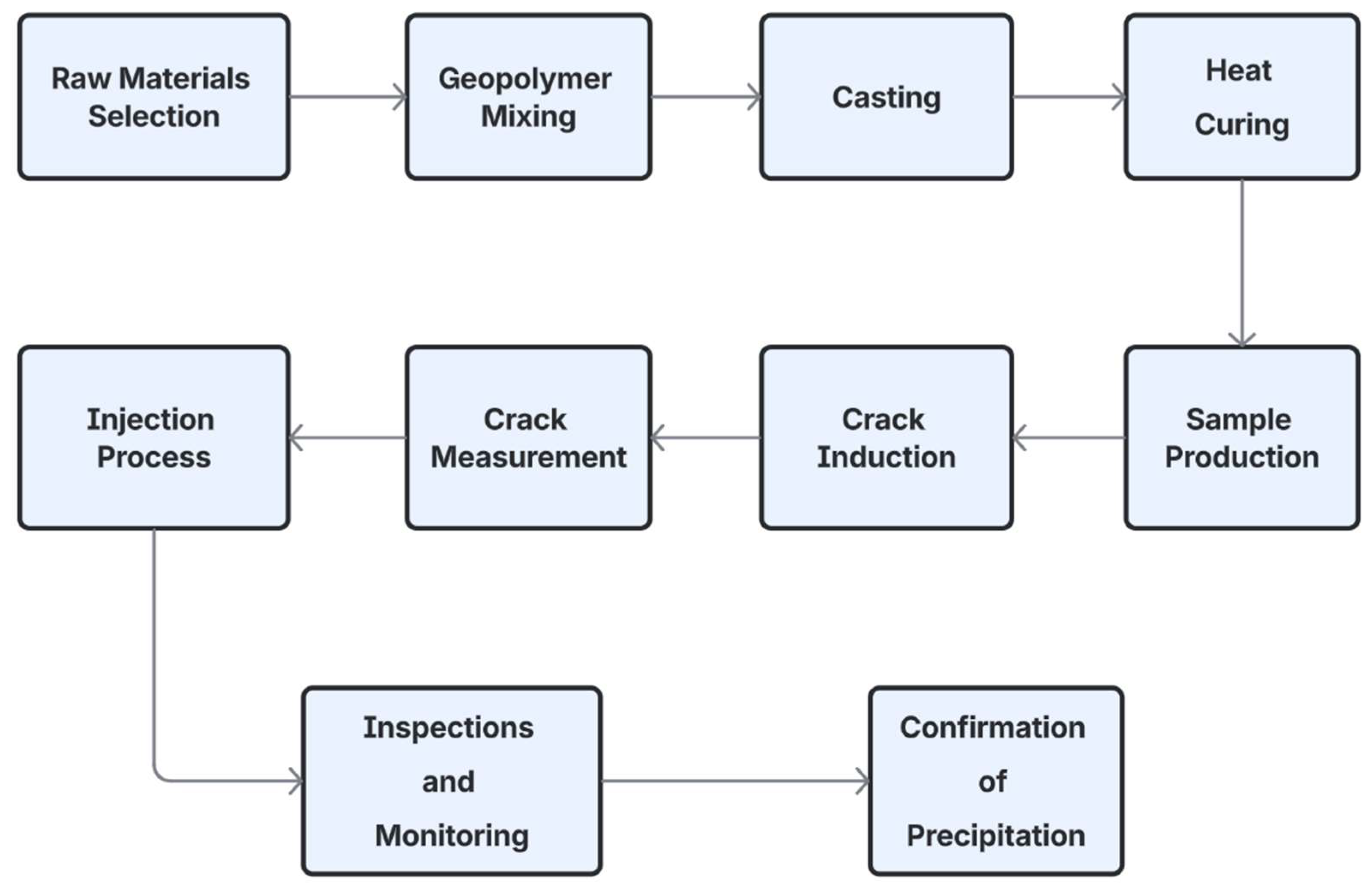

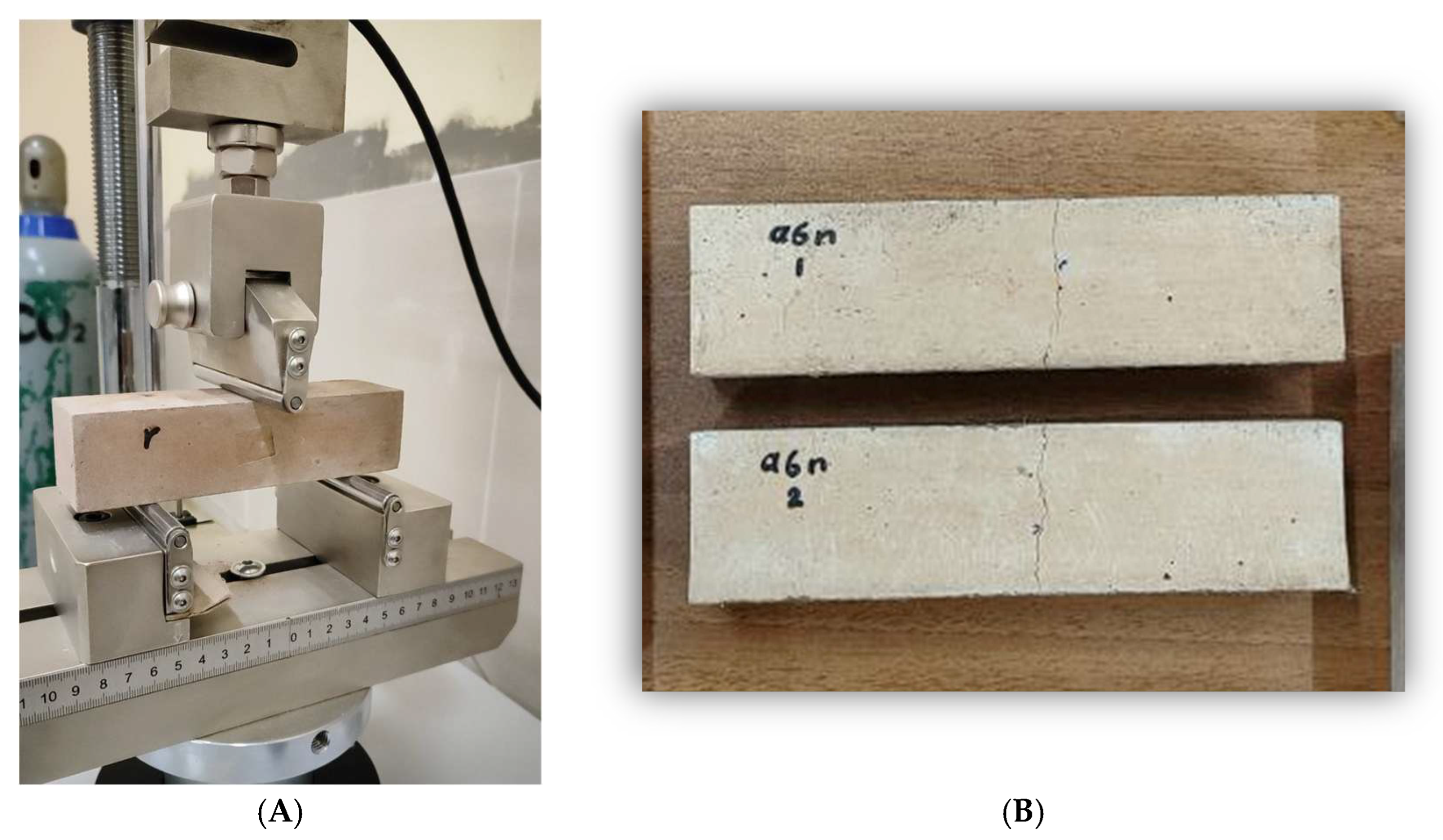
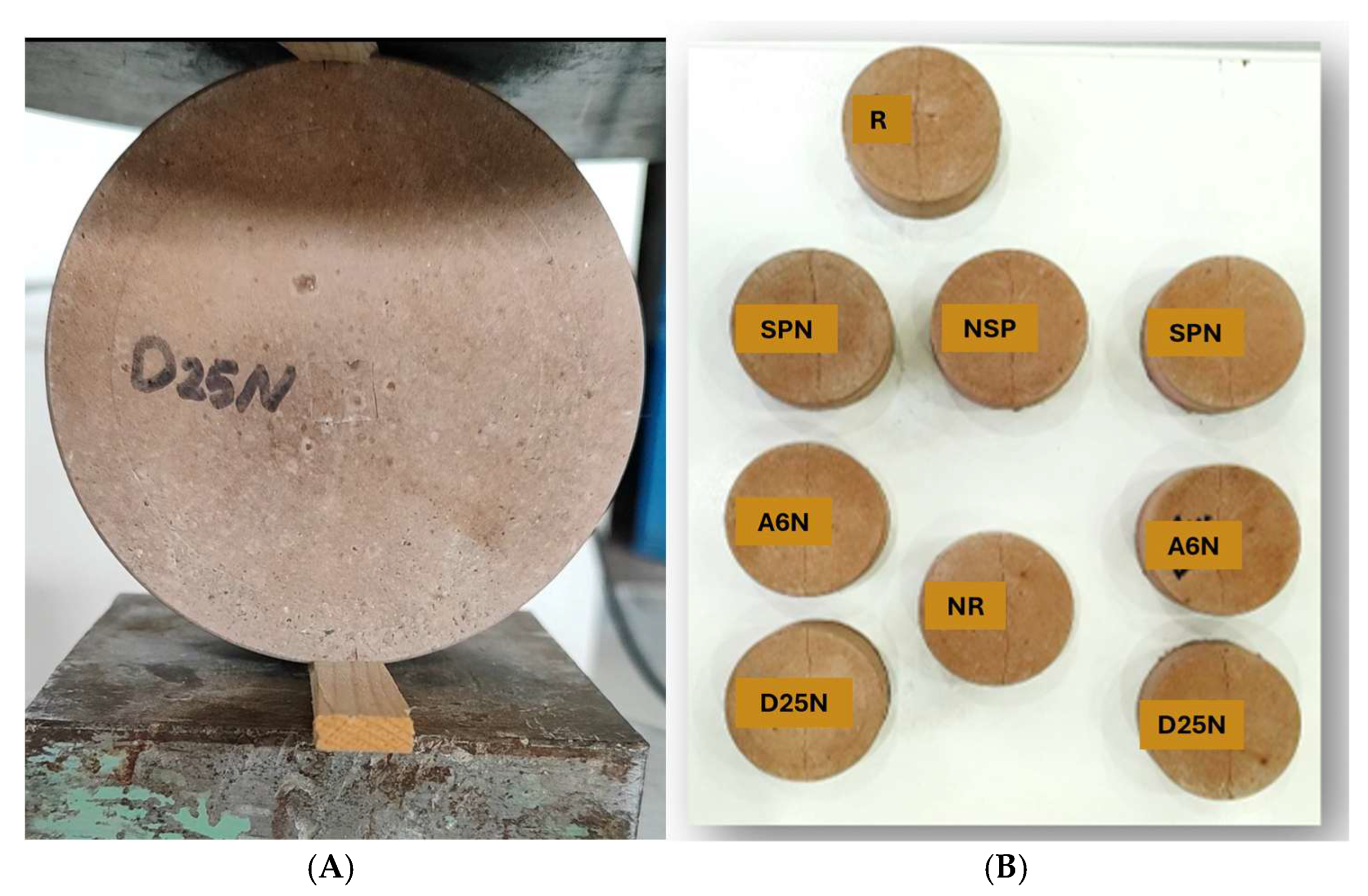
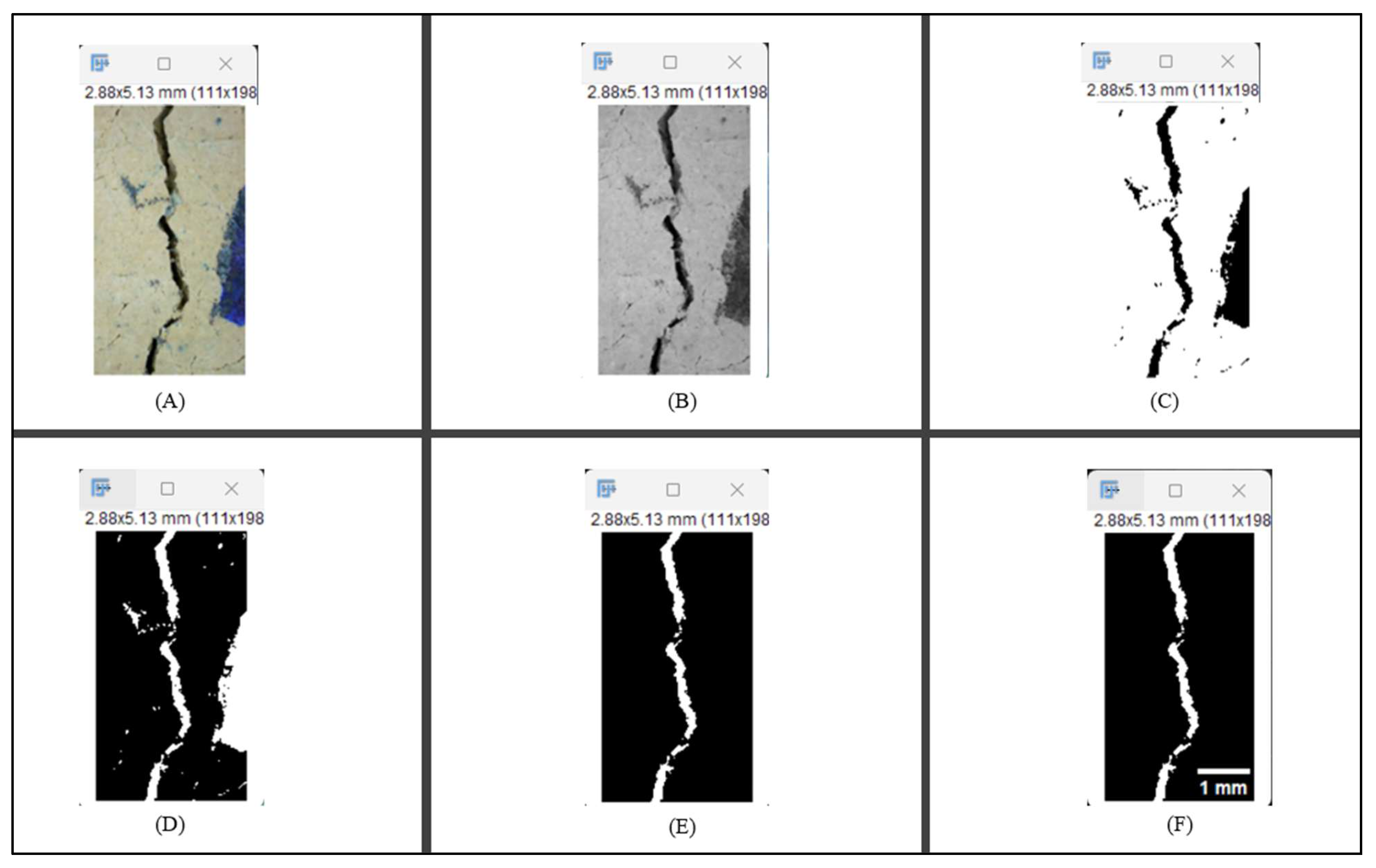


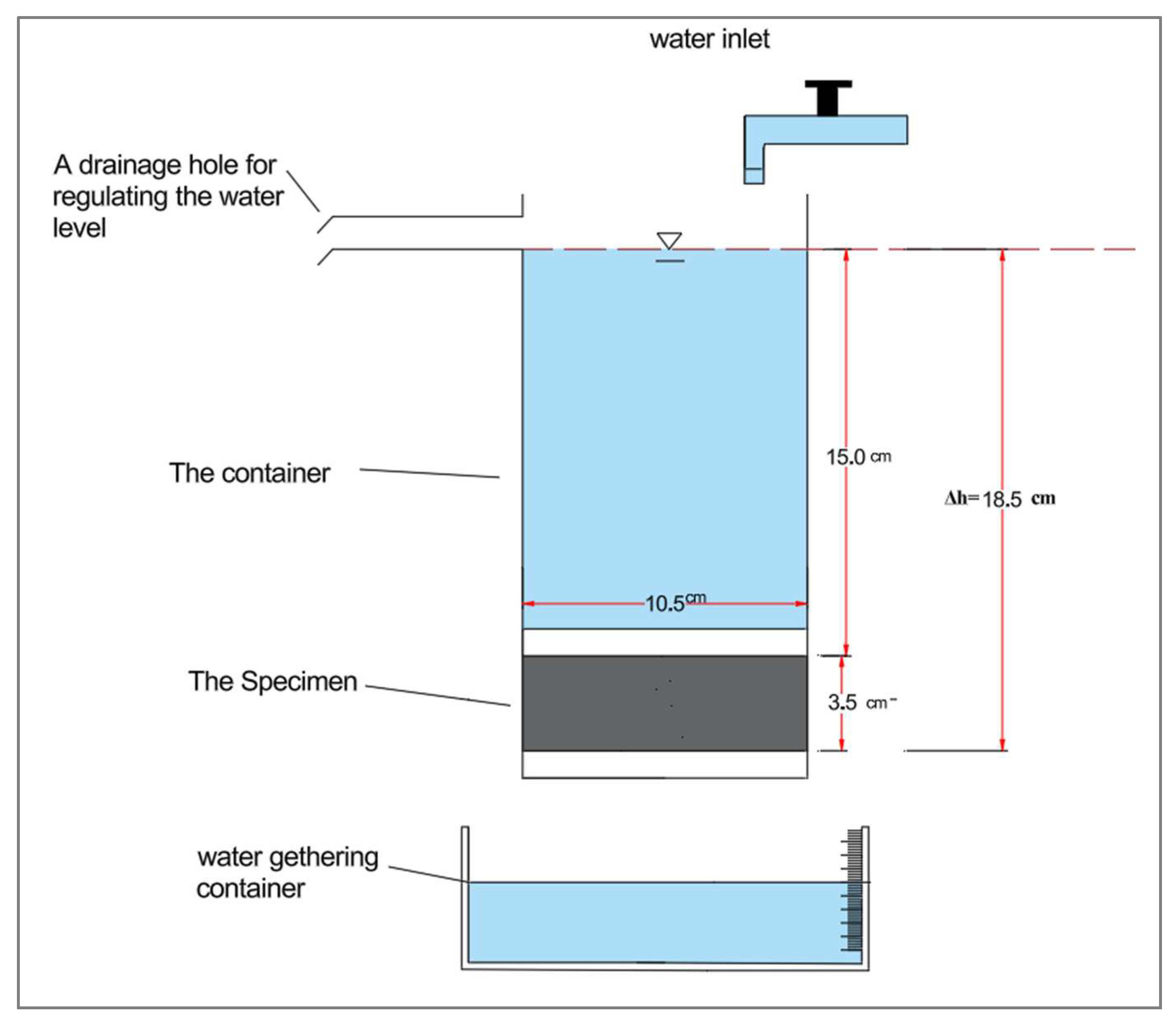
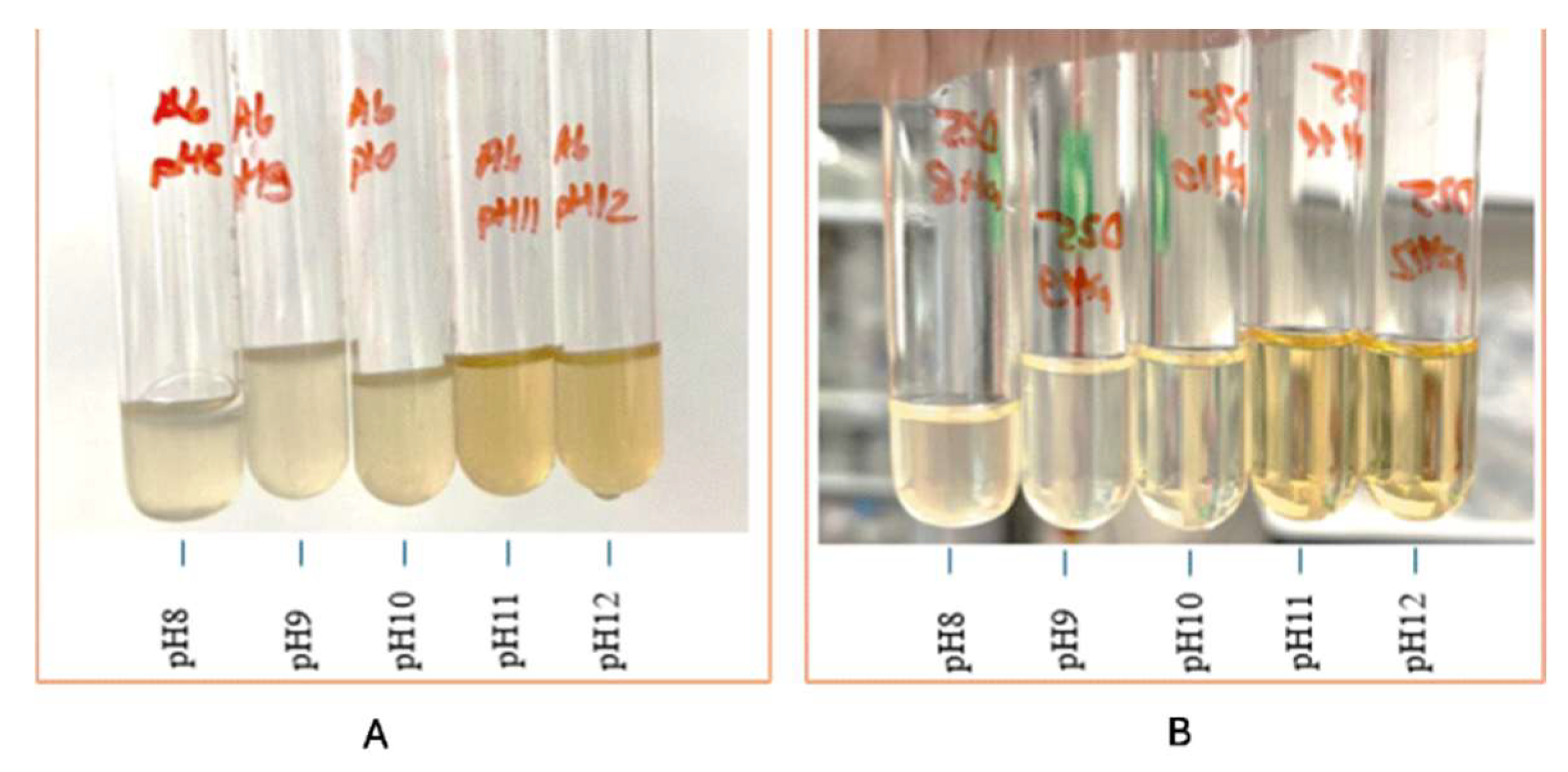


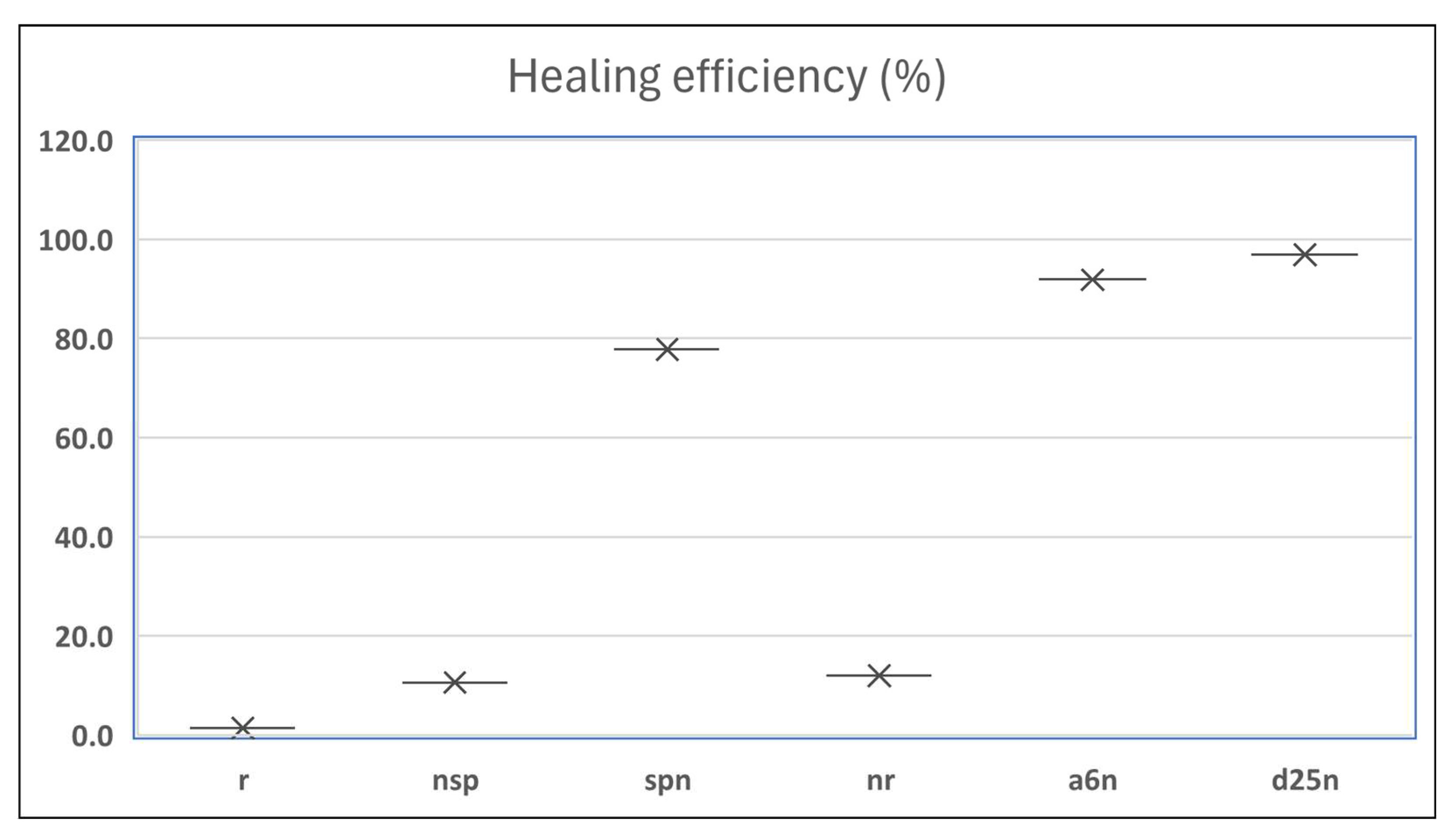
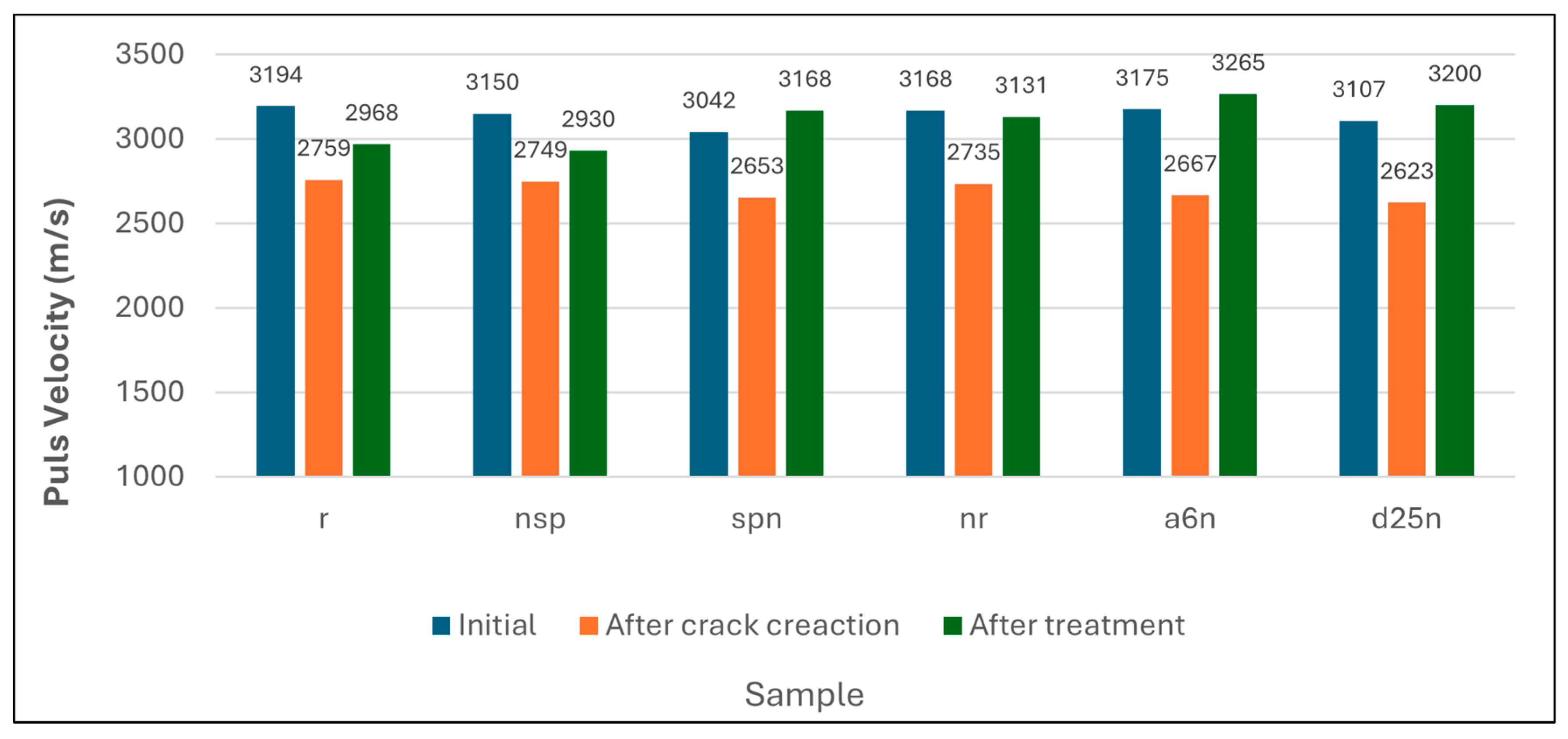
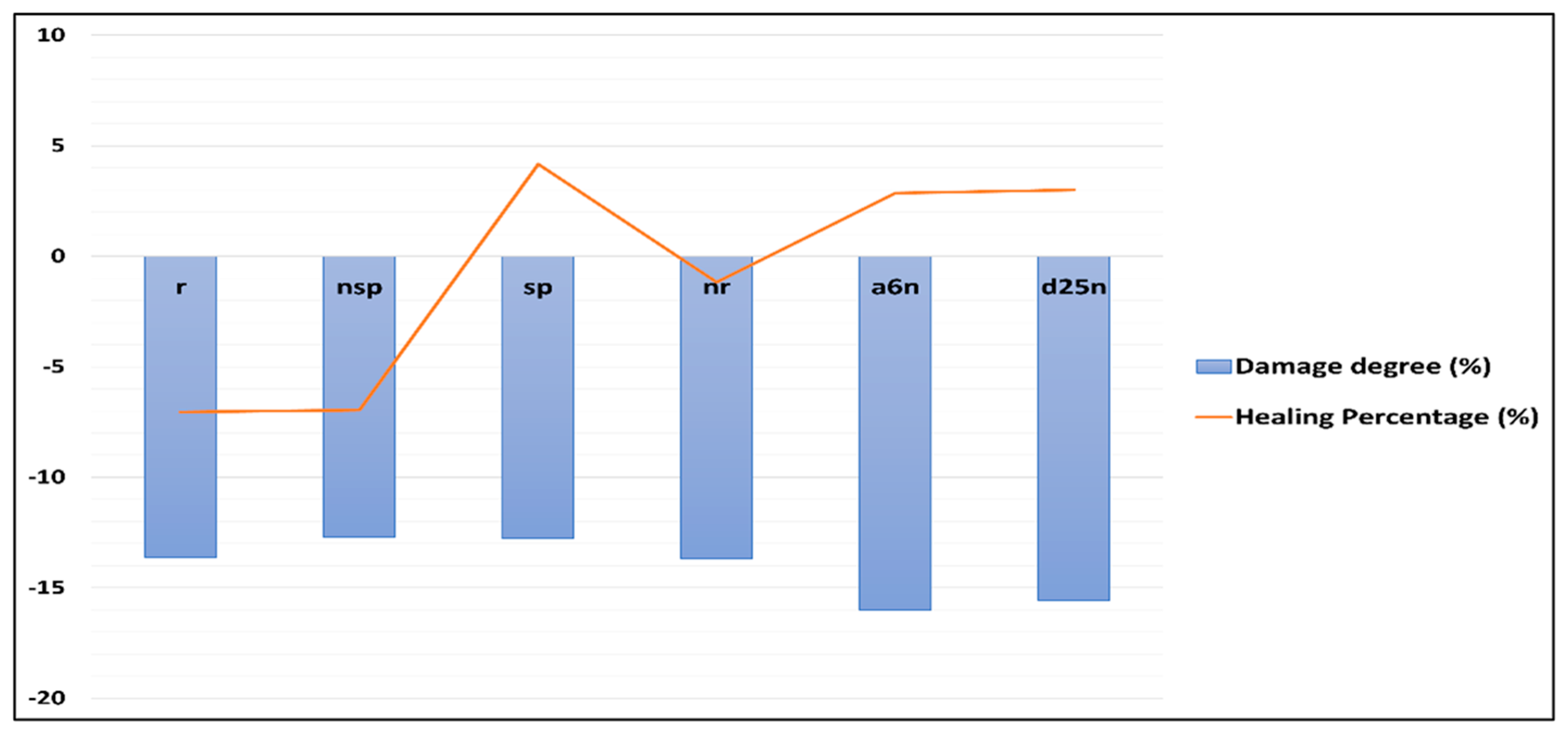
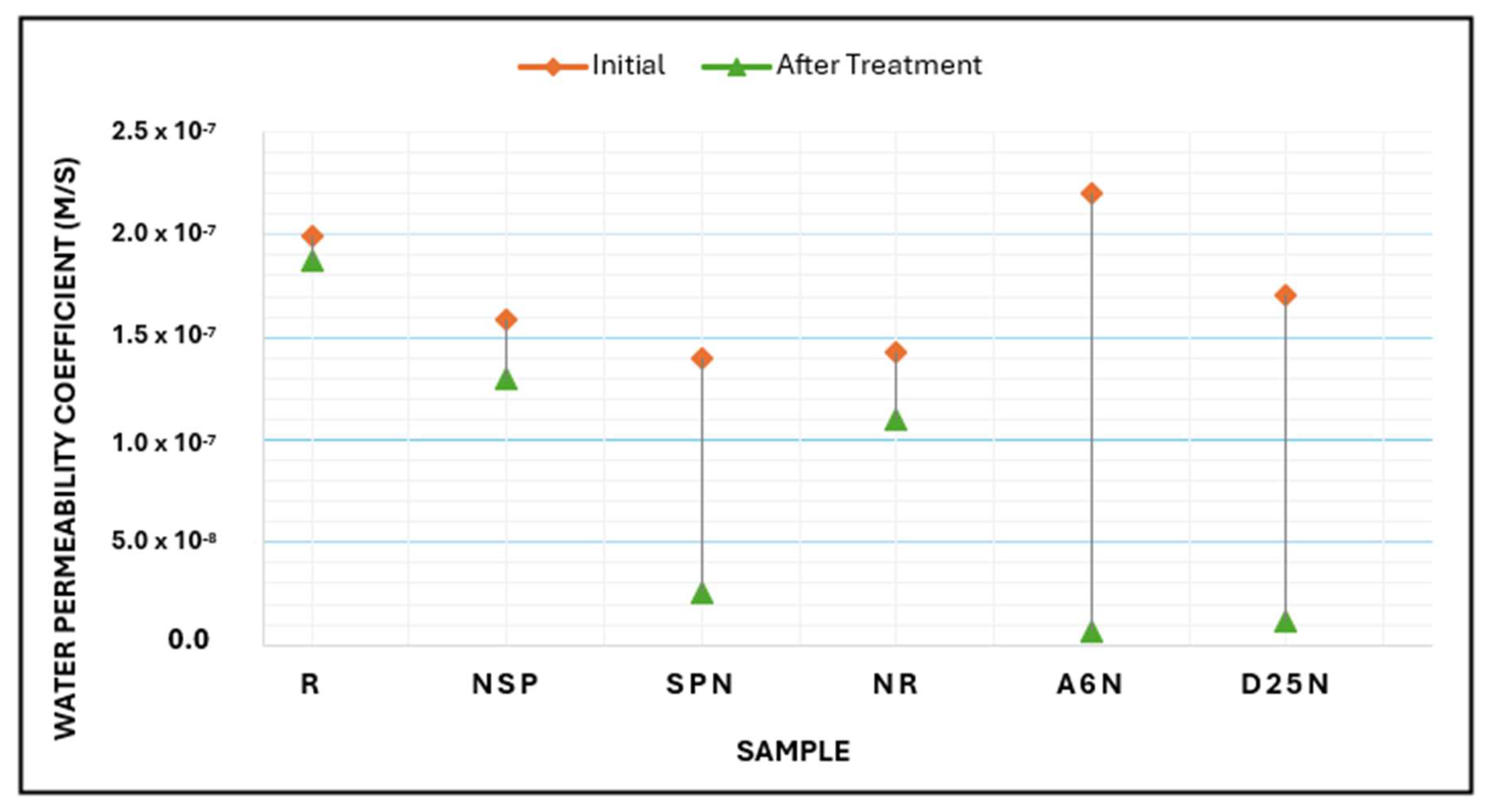
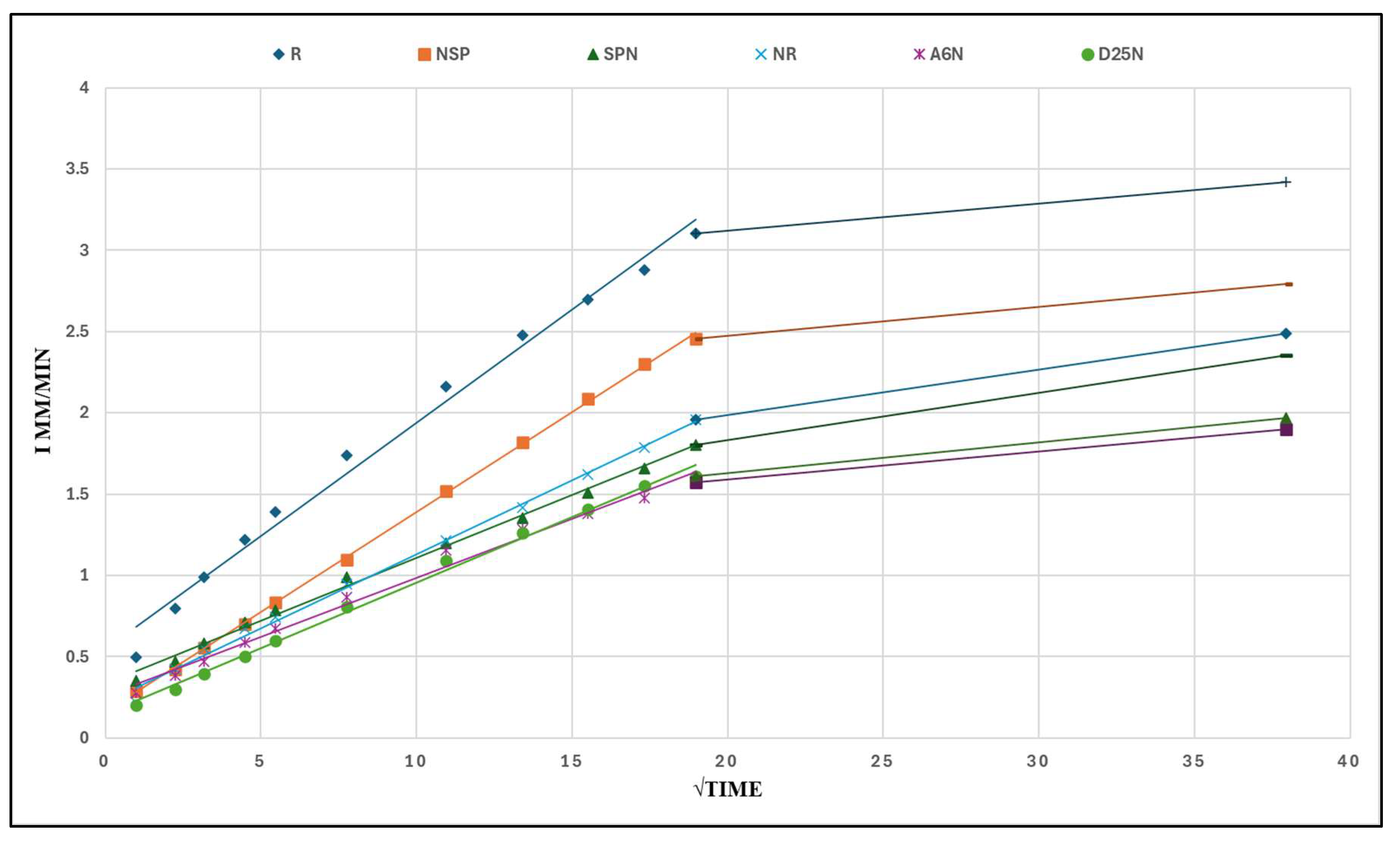
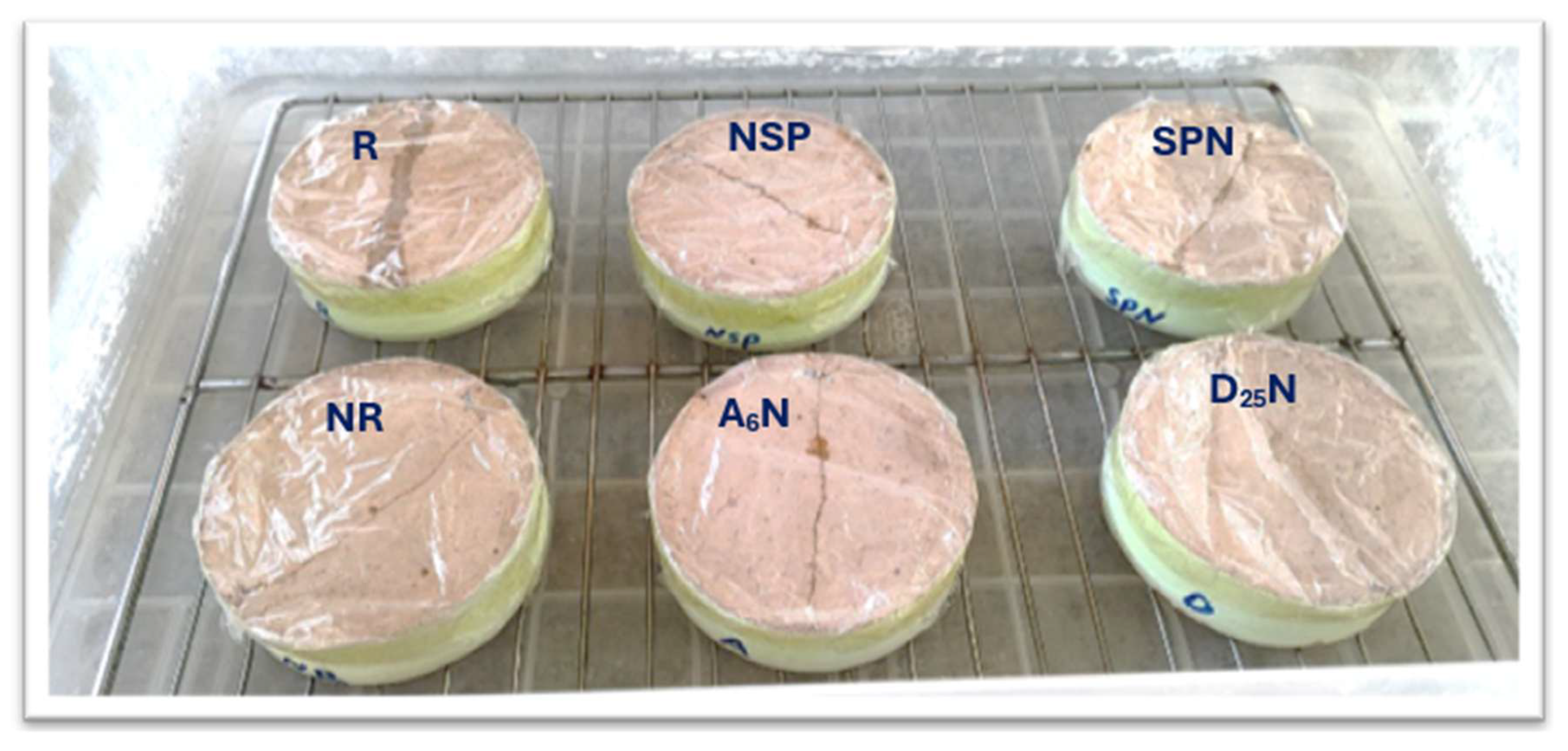
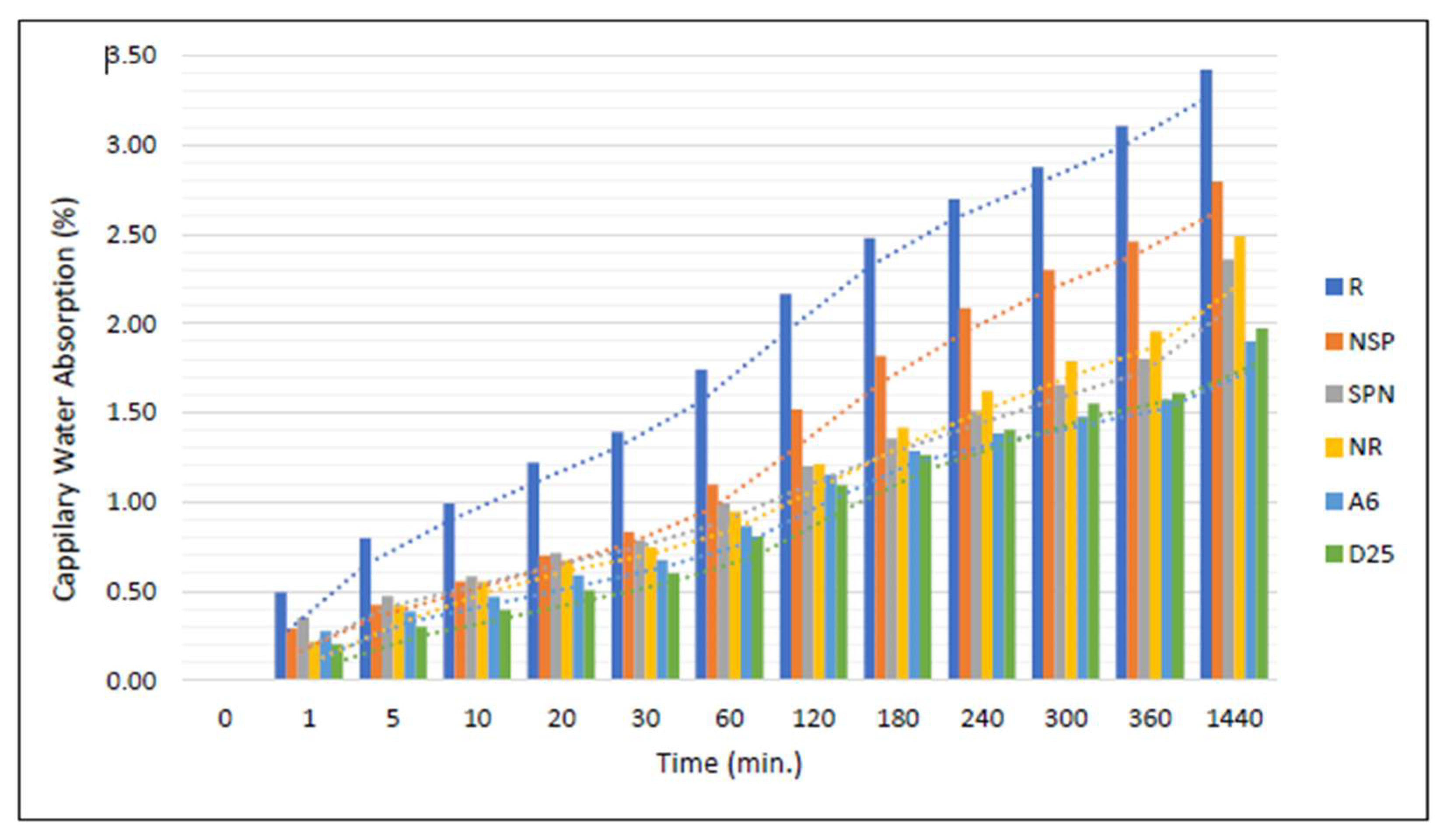
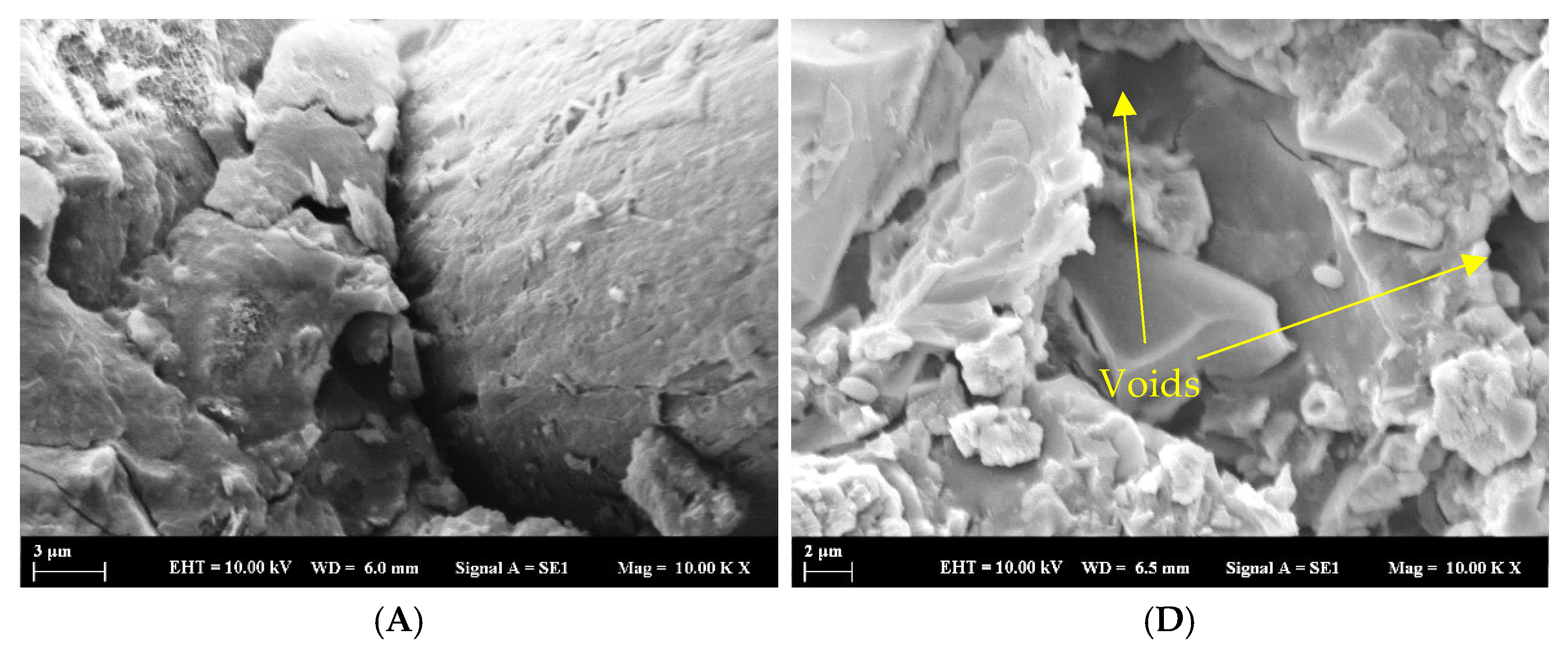
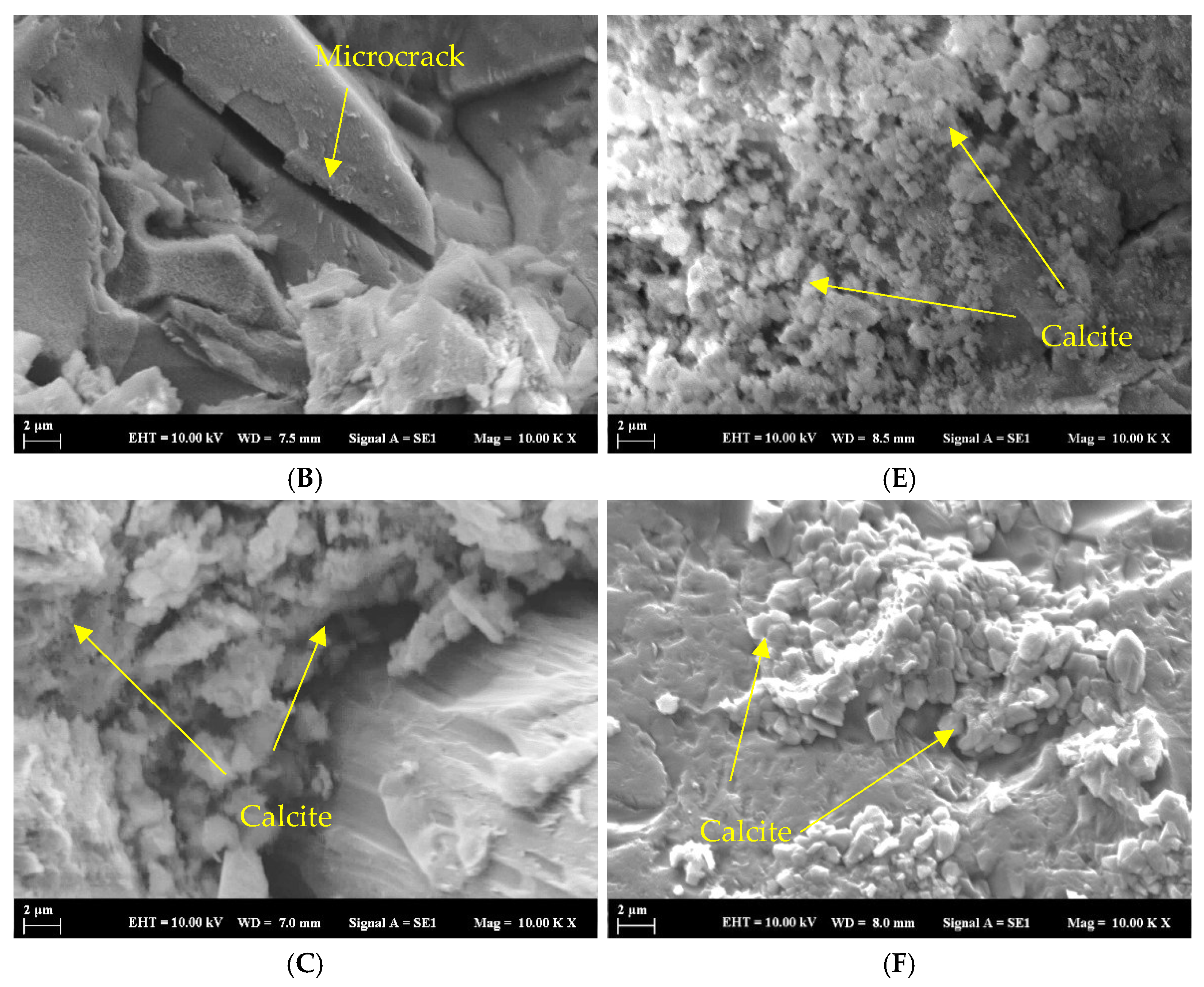


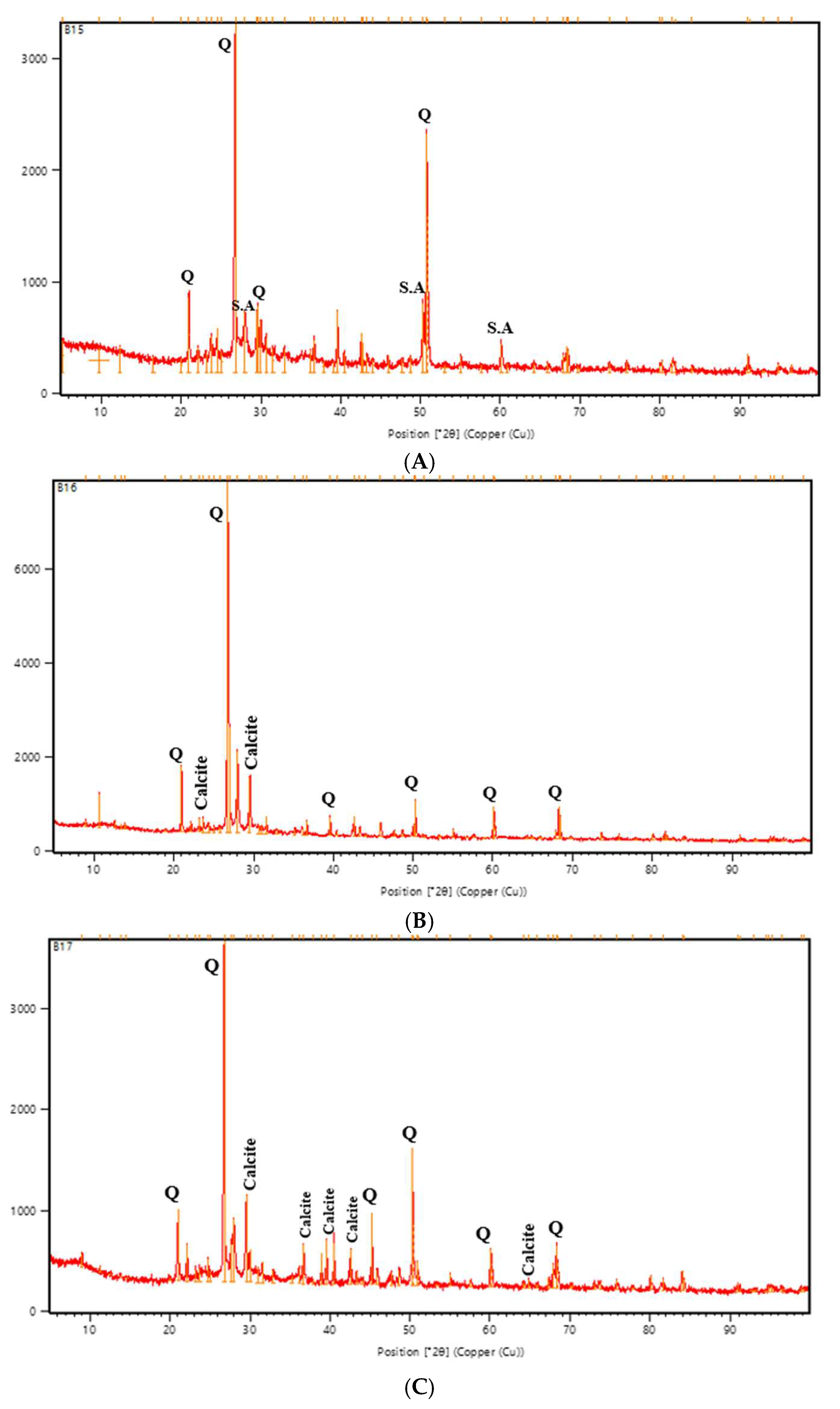
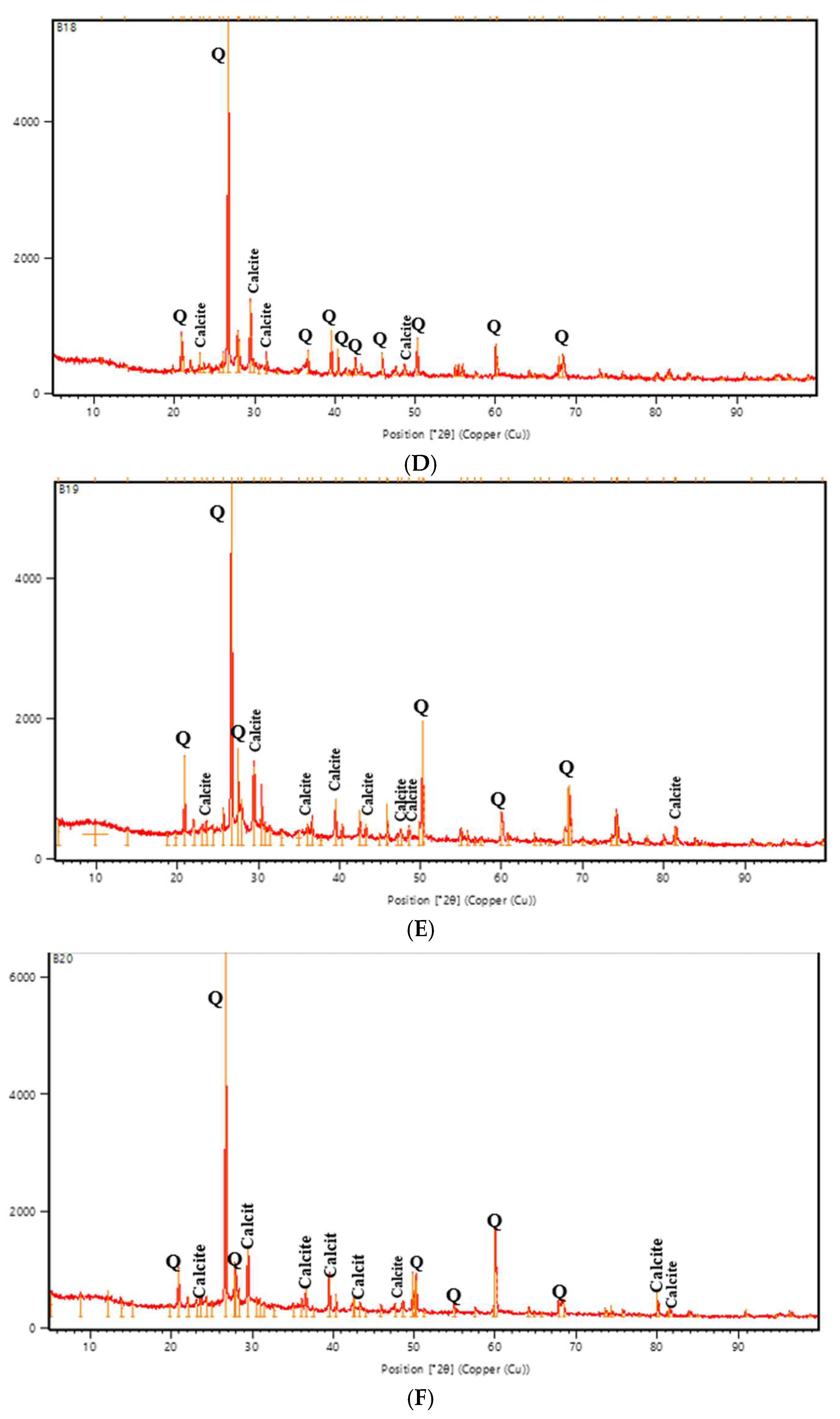
| Oxide | Percentage (%) | |
|---|---|---|
| GGBS | CWP | |
| SiO2 | 35.92 | 60.42 |
| Al2O3 | 9.02 | 16.00 |
| CaO | 53.06 | 15.38 |
| Fe2O3 | 1.99 | 8.20 |
| Binder | GGBS | CWP | Sand | Activators | Fiber | |
|---|---|---|---|---|---|---|
| NaOH | K2SiO3 | |||||
| 1 | 0.5 | 0.5 | 2.5 | 0.22 | 0.43 | 0.005 |
| Medium Type | Main Components/1 L | Bacterial Isolates Codes | Notes |
|---|---|---|---|
| ATCC Medium 1376 | Tris’s base: 6.05 g, (NH4)2SO4: 10.0 g, Yeast extract: 1 g, Glucose: 1 g, Urea: 20 g, pH: 9 | SP | |
| ½ Tryptic Soy Agar (½ TSA) | Tryptone: 8.5 g, Soy peptone: 2.5 g, NaCl: 2.5 g, Agar: 15 g, pH: 7.3 | A6 & D25 | Autoclave at 121 °C for 15 min |
| ½ Tryptic Soy Broth (½ TSB) | Tryptone: 8.5 g, Soy peptone: 2.5 g, NaCl: 2.5 g, pH: 7.3 | A6 & D25 | Liquid medium; Autoclave at 121 °C for 15 min |
| Calcium Lactate Solution | Calcium lactate: 20 g, Distilled water: 1000 g | For all strains | Dissolved, autoclaved, and used as a mineralization stimulant |
| Group No. | Sample Code | Injected Medium |
|---|---|---|
| 1 | r, R | Reference samples without any injection process |
| 2 | nsp, NSP | ATCC + calcium lactate |
| 3 | spn, SPN | SP bacteria + calcium lactate |
| 4 | nr, NR | 1/2TSB + calcium lactate |
| 5 | a6n, A6N | A6 bacteria + calcium lactate |
| 6 | d25n, D25N | D25 bacteria + calcium lactate |
| Sample Shape | Group | Sample Code | Method of Creating Cracks in Specimens | Treatment Method After Crack Creating | Investigation of Healing Efficiency |
|---|---|---|---|---|---|
| Prisms (4 × 4 × 16) cm | 1 | r | cracks were made by applying load at a displacement speed rate of 0.2 mm/min. | 21 °C and RH ≥ 65 | Crack Monitoring, Crack Area measurement, and UPV (Recovery) |
| 2 | nsp | Injection with different mediums as detailed in Table 4 | |||
| 3 | spn | ||||
| 4 | nr | ||||
| 5 | a6n | ||||
| 6 | d25n | ||||
| Cylinders (3.5 h, 10.5 Ø) cm | 1 | R | Single cracks were made by splitting tensile load at load rate of 0.05 KN/s. | 21 °C and RH ≥ 65 | Healing efficiency, water permeability, and capillary water absorption tests |
| 2 | NSP | Injection with different mediums as detailed in Table 4 | |||
| 3 | SPN | ||||
| 4 | NR | ||||
| 5 | A6N | ||||
| 6 | D25N |
| Group | Before Treatment | After Treatment | Processed by ImageJ Software | |
|---|---|---|---|---|
| Before Treatment | After Treatment | |||
| R | 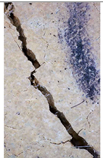 | 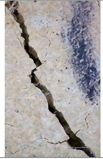 |  |  |
| NSP |  |  |  |  |
| SPN |  |  |  |  |
| NR |  |  |  |  |
| A6N |  |  |  |  |
| D25N |  |  |  |  |
| Sample | Area of Crack (mm2) | Healing Efficiency (%) | |
|---|---|---|---|
| Before Treatment | After Treatment | ||
| r | 1.399 | 1.380 | 1.4 |
| nsp | 1.718 | 1.536 | 10.6 |
| spn | 0.731 | 0.162 | 77.8 |
| nr | 1.035 | 0.911 | 12.0 |
| a6n | 0.85 | 0.069 | 91.9 |
| d25n | 0.811 | 0.025 | 96.9 |
| Specimen | Average Crack Width (µm) | Permeability Coefficient K (m/s) × 10−7 | |
|---|---|---|---|
| Initial | After Treatment | ||
| R | 230 | 2.0 | 1.9 |
| NSP | 247 | 1.6 | 1.3 |
| SPN | 200 | 1.4 | 0.3 |
| NR | 227 | 1.4 | 1.1 |
| A6N | 203 | 2.2 | 0.1 |
| D25N | 260 | 1.7 | 0.1 |
| Specimen | Absorption (%) | Related to the Control (%) |
|---|---|---|
| R | 4.4 | 100 |
| NSP | 3.5 | 79.7 |
| SPN | 3.0 | 68.5 |
| NR | 3.3 | 74.7 |
| A6N | 2.4 | 55.5 |
| D25N | 2.5 | 56.8 |
Disclaimer/Publisher’s Note: The statements, opinions and data contained in all publications are solely those of the individual author(s) and contributor(s) and not of MDPI and/or the editor(s). MDPI and/or the editor(s) disclaim responsibility for any injury to people or property resulting from any ideas, methods, instructions or products referred to in the content. |
© 2025 by the authors. Licensee MDPI, Basel, Switzerland. This article is an open access article distributed under the terms and conditions of the Creative Commons Attribution (CC BY) license (https://creativecommons.org/licenses/by/4.0/).
Share and Cite
Al Hayo, B.; Canpolat, O.; Doğruöz Güngör, N.; Uysal, M.; Ahamada Rachid, N.; Ali, I. Experimental Verification of Calcite Formation Potential by Ureolytic and Non-Ureolytic Bacterial Strains in Geopolymer Mortar. Materials 2025, 18, 4795. https://doi.org/10.3390/ma18204795
Al Hayo B, Canpolat O, Doğruöz Güngör N, Uysal M, Ahamada Rachid N, Ali I. Experimental Verification of Calcite Formation Potential by Ureolytic and Non-Ureolytic Bacterial Strains in Geopolymer Mortar. Materials. 2025; 18(20):4795. https://doi.org/10.3390/ma18204795
Chicago/Turabian StyleAl Hayo, Bashar, Orhan Canpolat, Nihal Doğruöz Güngör, Mücteba Uysal, Nahdhoit Ahamada Rachid, and Issam Ali. 2025. "Experimental Verification of Calcite Formation Potential by Ureolytic and Non-Ureolytic Bacterial Strains in Geopolymer Mortar" Materials 18, no. 20: 4795. https://doi.org/10.3390/ma18204795
APA StyleAl Hayo, B., Canpolat, O., Doğruöz Güngör, N., Uysal, M., Ahamada Rachid, N., & Ali, I. (2025). Experimental Verification of Calcite Formation Potential by Ureolytic and Non-Ureolytic Bacterial Strains in Geopolymer Mortar. Materials, 18(20), 4795. https://doi.org/10.3390/ma18204795








